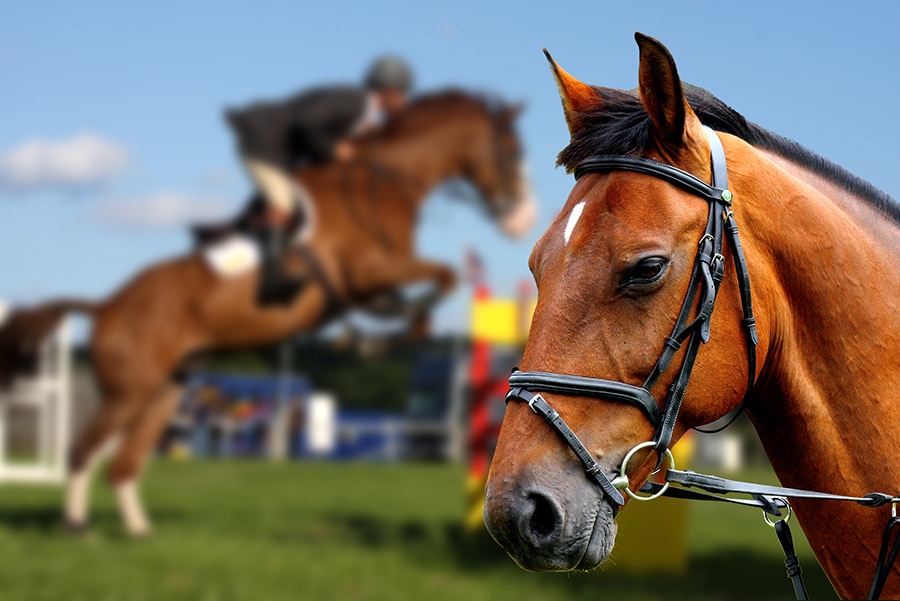Whether your arena is indoors or outdoors, the footing you choose will affect horse performance. Understanding how your horse moves, being knowledgeable about surface properties, and selecting the proper arena footing affects horse performance and their health.
The Properties of Footing
Surface properties can have a significant effect on your horse. No matter which riding discipline you practice, it’s essential to understand how your footing properties come into play when riding and training.
Firmness, cushion, and grip are horse arena footing properties to be knowledgeable about when building a new arena or replacing old footing. Regardless of your discipline, your surface should return energy to your horse. Your footing should also absorb impact and reduce shock waves, preventing soft tissue injuries in your horse. Here are three surface characteristics to keep in mind while choosing your footing.
Firmness: How hard or soft the surface is will impact the support and directly impact your horse’s experiences.
Cushion: A surface with poor cushioning will put stress on your horse’s legs. Instead, your cushion should help return energy, reducing the likelihood of injury.
Grip: Proper grip is crucial when a horse is landing and pushing off of the ground. A riding arena that is too slippery will make it difficult for your horse to stop and push off properly. On the opposite end, an arena surface that has too much friction may lead to injury.
The Footfall Phases of A Horse
When a horse interacts with a surface, its footfall phases come into play. Understanding the correlation between your horse and any surface with their performance and rate of injury is vital for choosing footing and making any adjustments to your arena.
The Impact Phase
This phase is when a horse’s hoof meets the ground and begins the deceleration process. During this process, joint and bone damage are possible due to shockwaves running up the horse’s legs.
The Loading Phase
In this phase, the horse’s entire foot is in full contact with your arena surface. A horse may encounter fractures during this phase due to poor arena footing, which causes their total weight to shift into their hooves.
The Push-off Phase
Also known as the breakover phase, this footfall phase occurs when a horse’s heel begins to rotate over the horse’s toe. This movement takes place when a horse is making its way into their next step.
Common Types of Footing and How They Impact Performance
Sand: Sand is commonly used in horse arenas. Most arenas use additives mixed with sand to stabilize their arena and provide cushioning. However, sand alone can easily become muddy, which can bog down your horse and hurt their performance. On the other end, sand that is watered infrequently may become loose and dusty, negatively impacting your horse’s grip.
Native soil: If your arena’s soil is naturally sturdy and has the proper composition, focusing on improving it through watering and shifting is a viable option. Otherwise, using synthetic materials and additives may be your best bet. If you choose native soil, but it is not stable, your horse and their performance may suffer.
Rubber mulch: Rubber mulch tends to be an expensive alternative. It works to create a synthetic surface mixed with soil. However, it retains heat leading to hardened mulch, and it also becomes slippery when wet. Both of these issues can quickly impact horse performance.
Stone dust: This type of footing mimics sand. Stone and sand are crushed into a fine powder resulting in stone dust. A downside to this footing is that it results in massive amounts of dust, which can negatively affect horse and rider health. Stone dust is also known to compact and can hurt a horse’s hoof when it contacts the ground.
How Your Horse Is At Risk
Unfortunately, a horse can become injured even if you have the right footing in place. Sometimes, accidents happen, but the good news is that you can reduce their chances of being affected by impact injuries with high-quality footing in place.
Three common surface issues to look out for are uneven footing, hard footing, and soft footing, all of which can lead to injury. Uneven footing can lead to poor performance and mild injuries. When a horse performs on footing that is too soft, it’s common for them to experience soft tissue injuries. Finally, footing that’s too hard can cause injuries to your horse’s hooves, joints, and even their bones.
The ideal surface for a horse arena is a riding surface that softens the impact on hooves upon contact, improves cushioning, and is level, stable and uniform.
The Ideal Footing For Horse Performance
At Performance Footing, we know that keeping your horses injury-free is crucial when building an arena or revamping your existing surface. Prevention matters to us too. That’s why we’ve designed footing products that not only help horses perform at their best but also reduce the risk of injury as well.
Our FoamFooting is an arena additive that improves comfort and safety for horses and their riders. FoamFooting is appropriate for many riding disciplines and works with you, not against you. It softens the impact on hooves through improved cushioning, does not require ample watering, does not promote dust, reduces the risk of injury, and can even lengthen your training sessions.
We understand that making the right decision is essential. Contact us at 877-835-0878, and we will be happy to answer your questions and help you get on “the right footing” today!
